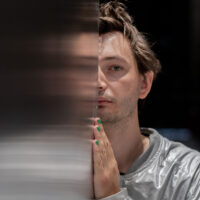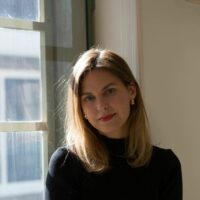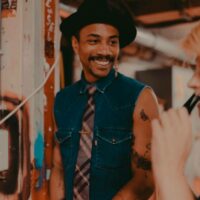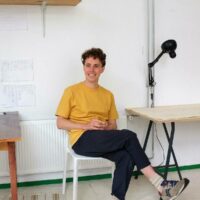We are happy to announce that from many compelling proposals submitted to an open call for the Design and the Deep Future Research Group 2022-23, the following have been selected:
Louis Braddock Clarke (tutor, Graphic Design, Hacklab - Geomedia)
Alexander Cromer (tutor, IST; study coach, Graphic Design)
Rana Ghavami (tutor, MA Industrial Design, IST Objects in Relation)
Carl Högberg (tutor, Fine Arts)
Victoria Meniakina (tutor, Interior Architecture & Furniture Design)
The proposals were reviewed by Alice Twemlow, Rosa te Velde and Martha Jager.
Overview of the participants and their research projects:
Weather Gardens: Active Listening to Drifting Geographies
How can plural acts of listening trigger imaginary climate narratives through field research?
Keywords: Listening, Climate Imaginaries, Sampling, Witnessing, Indigenous Knowledge, Geological Acceleration, Weather, Telluric Currents, Amplifying, Translating, Walking & Talking, Non-human Agency, Climate Intimacy, Spectral Thinking.
Weather Gardens is a proposed method, discourse, and space for the act of listening at sites of geological disturbances. The project focuses on hearing as a practice to pluralise and amplify the sonic signatures of ecologies, to further open up potentials for climate imaginaries. Listening to the landscape as a whole (people, materials, animals), and through varying magnitudes, allows for research that steps away from being fixed and into an active mode of telluric-drifting. How can sound create intimacy with the Earth as it goes through rapid shifts due to the climate emergency? What are the new sonic signatures of the Anthropocene?
Voicing Unverifiable Realities Beyond the Archive: Ecological Crisis and the African Diaspora
How can voice help us to imagine the unverifiable realities that exist outside of the archive? And further, how can such a practice contribute to alternate means of historicizing and analyzing the ongoing realities of ecological crisis within the African Diaspora?
Keywords: Voice, Storytelling, Spoken word, Black Ecology, Care, Ancestral Communication, Poetry, Critical Fabulation
Ethics in Methods: Aesthetics, sense-making and the ongoingness of colonial histories
How is dispossession, displacement and the severing of the relational ties between people, labour and lands not only investigated, exposed, storied, and visualised, but also, how is it historicised in design education in relation to the ongoingness of colonial and imperial histories? What are the ethical implications of the ways in which methods are taught in design education? How do practices of (re)presentation carry ethical meanings, and how are they embedded in decolonial aesthesis and aesthetics as sense-making?
Keywords: Material as Witness, Tracing as Method, Story-Telling, Practices of (Re)Presentation, Embodied Knowledge, Aesthetics as Sensing and Sense-Making, Ethics, Methods, Decolonial Aesthesis, Critical Design Pedagogies.
Madder: We Are All Pigments
What would a student-driven, academy-wide, speculative pigment research laboratory look like? Could pigments act as agents and carriers for environmental storytelling, for the critical, for the poetic?
Keywords: Madder; Matter; Decoloniality; Dyestuffs; Storytelling; Toxicology; SF; Earthlessness
Situating the Postnatural: Material (An)archaeologies and Displaced Bodies
Keywords: Natureculture, Postnatural, (Dark) Ecologies, Toxicity and Contamination, Multispecies, Postcolonialism, Ecofeminism, Intersectionality, Practices of Care
What is the role of design in containing, altering and controlling nature as a part of the colonial project? How botanical gardens facilitate the exploitative and extractive culture of design, displacements of species and act as laboratories containing material histories and stories across different scales and temporalities? What is the notion of natural, artificial, synthetic, native and exotic in the postnatural context? How can we create new ways of understanding matter, relate to and with non-human beings, and build ecological awareness by listening to the garden?
Earlier this year, I spent some time in a remote village on the Italian-Slovenian border,called Topolo. I was building a website for a collective called Robida. Robida’s practice questions what it means to live in the margins. During the conceptualisation and development of the website, the question of how best to represent the collective kept arising. The website should reflect a locality, it should reflect the geographic location and all that comes with it. It got me thinking about what it means for a digital space (i.e a website), which is accessible anywhere in the world, to be imbued with a sense of locality and place.
How can you begin to map the geography, the ecology, the society and technology that makes such a space a place. In my work with Radio, I have witnessed how a publishing tool and digital infrastructure can simultaneously become a community building device that entangles itself with the activities of a local space. Whilst it is simultaneously a device that activates people engaged with that space to broadcast their actions, it also becomes a tool to record that same activity and archive it. In this regard, the radio becomes a digital space that is highly contextual and place-full. Whilst it may not be able to visually present an overview of what that physical place looks like, the life that goes on there is translated into its programme, its web design,
its jingle and its archive. This infrastructure also seems to open up a space of care that fosters autonomy as well as interdependence. In this space maintenance, organisation, and administration are just as important as hosting shows and producing events and programmes.
During the Research Group selected tutor-researchers will work not only on individual projects but also collaboratively, as a group, on a range of initiatives and interventions that respond to the central imperative of the Design & the Deep Future research project.
The project explores ways in which design and art can intervene in or interpret various aspects of climate catastrophe, planetary degradation and the loss of biodiversity. Sub-themes include, but are not restricted to:
Geological time
Infrastructures of waste and trash
Repair and re-use
Matter and materials
Bio design
Space junk
Digital detritus
Plastics and microplastics
Ferality and contamination
Climate imaginaries
Climate migrations
Climate justice
The collective aspects of the group will include creating a lexicon of key terms (visual and text), collating an open-source library of references and resources, nurturing an international network of allied researchers and making and sharing essays (text, audio, visual and video). We are also concerned with developing and explicating new methods for researching this topic and for embedding it in education at KABK. The Group’s work will culminate in a conference, publication, online platform and exhibition at the end of the year.
Tutors in all departments (both in Design and in Fine Arts) were invited to apply, provided that they will be employed as a tutor at the KABK for the full duration of the Group September 2022 - June 2023. Tutors selected for the Group will attend at least 10 all-day gatherings and use the time between sessions to further develop their projects.




